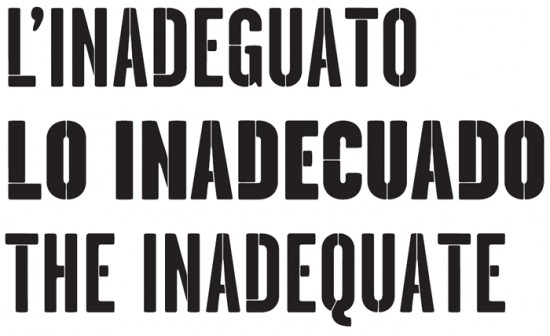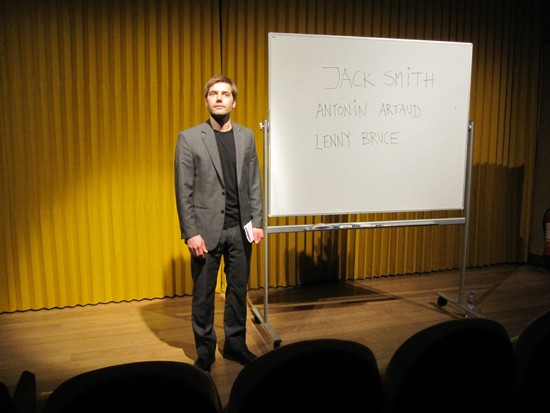 From “The Inadequate,” Spanish Pavilion at the 54th Venice Biennale.
From “The Inadequate,” Spanish Pavilion at the 54th Venice Biennale.Born in 1965 in Valladolid, Spain, and currently based in Brussels, Dora García uses live actions, institutional space and online platforms to explore the dynamics between performance and spectatorship. She has been selected to represent Spain at the 54th Venice Biennale, in an exhibition entitled “The Inadequate.” ART iT corresponded with her to learn more about her plans for Venice and how they relate to her broader artistic practice.
Interview:
ART iT: You are known for projects that explore the dynamics between scripted and spontaneous action and how situations affect behavior. How does the situation of national representation affect your approach to the Venice Biennale? Is this something that you will address directly in your exhibition?
DG: I feel very ill at ease with representing a nation. I think obviously the structure of national pavilions is anachronistic, and that is its default but also its virtue. Most probably the Venice Biennale has very little to do with art. Contemporary art is not made to be visited quickly and at such a massive scale. Often, the visitors to the Biennale literally run through the exhibition. Everything is a bit ridiculous and again that is both a problem and an advantage. I have tried to make a project that honestly deals with all those contradictions and malaise. It is indeed a project that is specially made for the Biennale, but very probably it is also completely inadequate for such an event, hence the title: “The Inadequate.”
ART iT: Your selection to represent Spain at Venice comes right as you are developing a project on social and artistic margins, “Mad Marginal: antipsychiatry tradition and marginality as artistic position, inspired by the thought and activity of Franco Basaglia.” Can Venice be considered a solely mainstream event, or does it allow room for deviants? Do you identify yourself as a mad marginal?
DG: I am not a mad marginal; I am merely a groupie of mad marginals. I like them, and I enjoy and frequent their company. I am an artist because I love some art and some artists and this project is, as with all the others, a strategy to spend time with them. Venice is everything: a mainstream event that as said has very little to do with art and a lot to do with social gathering; but it has many fringe events and structures and every possible attitude has room to fit. So my proposition too, why not? Franco Basaglia was born in Venice and I think he died there as well.
ART iT: Your recent performance projects have portrayed a series of fictitious and real characters, such as the beggar Filch from “Beggar’s Opera,” the comedian Lenny Bruce, the actor William Holden and the filmmaker Jack Smith. Does this focus on characters mark a shift in your attitude towards performance from earlier projects like the series “Inserts in Real Time”?
DG: No, these works all lie on a continuum. “Inserts in Real Time” was a structure created for what I called at the time, “low profile performance, barely distinguishable from daily life,” which in spite or in fact because of its low key-ism, managed to create the constant suspicion that something was going on – representation, performance, act, character. Slowly a feeling of comedy and humor emerged, the idea of comedy as critical tool (Bruce, Smith, Brecht) and the idea of verfremdung – estrangement – led to the present performance work.

 Top: Just Because Everything Is Different It Does Not Mean That Anything Has Changed, Lenny Bruce In Sydney (2008), video HD, 60 min. Collection Centro de Arte Dos de Mayo, CA2M, Móstoles, Madrid. Bottom: Performance view of Real Artists Don’t Have Teeth (2010). Performer: Jakob Tamm. Courtesy Moderna Museet and Index, Stockholm.
Top: Just Because Everything Is Different It Does Not Mean That Anything Has Changed, Lenny Bruce In Sydney (2008), video HD, 60 min. Collection Centro de Arte Dos de Mayo, CA2M, Móstoles, Madrid. Bottom: Performance view of Real Artists Don’t Have Teeth (2010). Performer: Jakob Tamm. Courtesy Moderna Museet and Index, Stockholm.ART iT: Many of your projects are extensively documented through writing on your website as well as in book form, and you often refer to the concept of novelization. For the reader, the diaries from “The Glass Wall,” for example, blur the line between documentation and fiction in a way that parallels the blurring of acting and normative behavior that occurs in the performance, while the texts that result from “The Notebook” also read as a kind of schizophrenic literature. Can you explain more about your relationship to writing and literature?
DG: I am a reader and an admirer of some writers; to me this has nothing to do with being intellectual, but is a matter of company and enjoyment. Short fiction has directly inspired many of my works, and the idea of the “diary” – literature-after-performance – came to me as a solution to the persisting problem of documentation. Documentation influences and changes performance. When a camera or a recorder is there, behavior changes, so I had to do without them, but then how to tell what happened? Through the diaries – diaries often not even written by me, but by the performer or the public. Diaries also create feedback: what you read or wrote yesterday influences the way things are or seem today. Then from the diary and the novel in turn came the idea of the script – the script and the speech – moving more towards theatre.
ART iT: To what extent do you anticipate your exhibition in the Spanish Pavilion will build upon or depart from your previous body of works?
DG: I think it will be a very natural outgrowth. Every work I do is a reaction to a situation in which I try to find a new equilibrium between the work I have done so far and the new situation. The first reaction when confronted with the prospect of Venice was embarrassment, malaise; I felt as if something was not quite fitting. So I have tried to adapt my baggage to that feeling.
The 54th Venice Biennale, “ILLUMInations,” opens to the public June 4 and continues through November 27.
Return to story index
Venice Biennale – ILLUMInations: 54th International Art Exhibition
